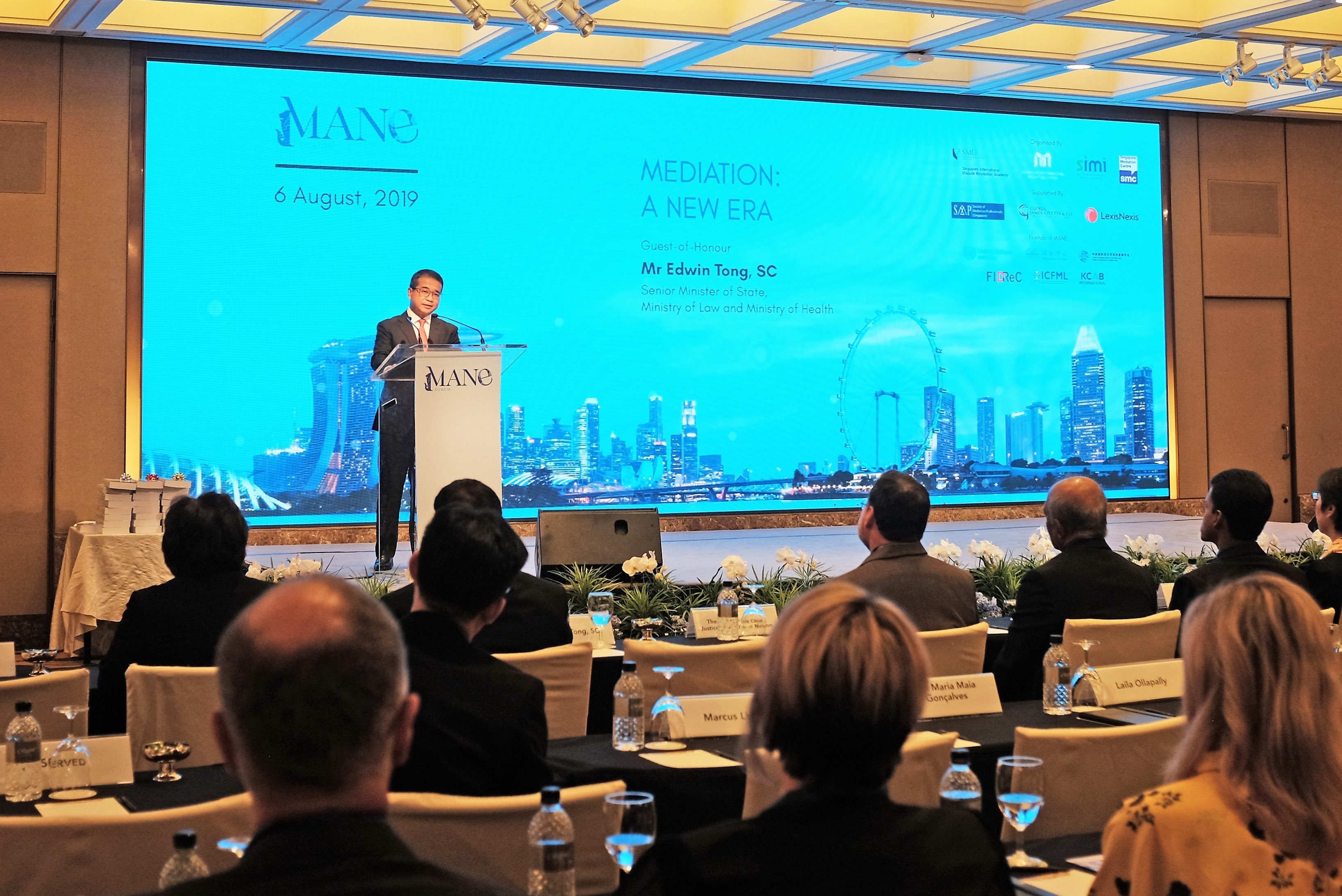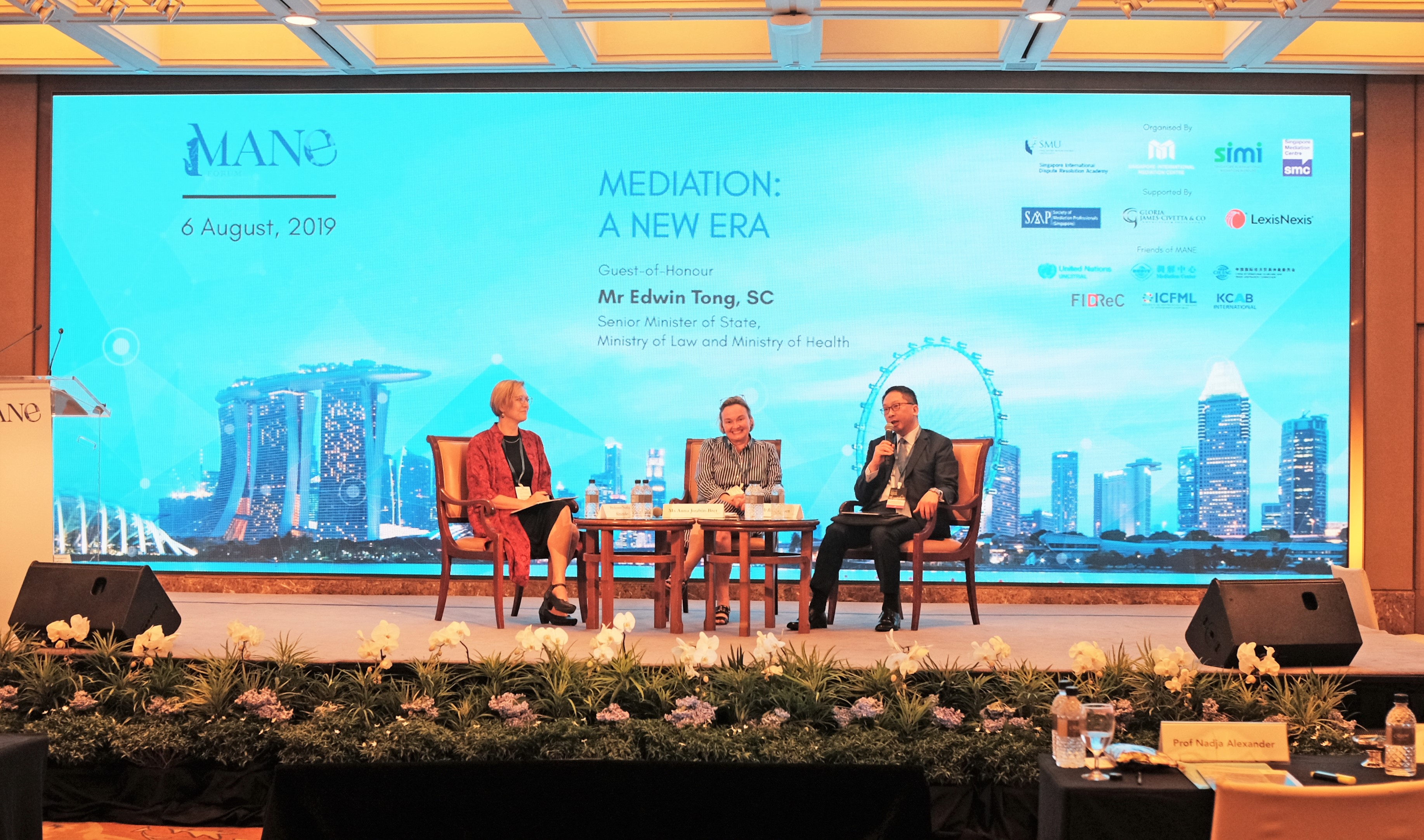
Above: Mr Edwin Tong, Singapore Senior Minister of State for Law and Health, speaking as guest of honour at the Mediation: A New Era (MANE) Forum.
By Rebecca Tan
SMU Office of Research & Tech Transfer – While working with overseas business partners comes with a host of benefits like access to new ideas, talent and markets, many firms are still held back by fears linked to dispute resolution. After all, doing business is never plain sailing; what happens when overseas partners inevitably disagree? Would the complexities of reaching a settlement across divergent legal systems lead to costs greater than the benefits of cooperation?
Instead of litigation and arbitration – both of which can be expensive and time consuming – cost-conscious companies can choose mediation to resolve their trade disputes. “The time and cost savings can be significant, but I would suggest that mediation saves a lot more than time and cost; mediation preserves harmony and ensures that relationships can continue to thrive,” said Singapore Senior Minister of State for Law and Health, Mr Edwin Tong, speaking as guest of honour at the Mediation: A New Era (MANE) Forum, which took place on 6 August 2019 at Regent Hotel Singapore.
Held on the eve of the signing of the historic Singapore Convention on Mediation, the MANE Forum was organised by the Singapore International Dispute Resolution Academy (SIDRA), a research centre of the Singapore Management University (SMU) School of Law, the Singapore International Mediation Centre, Singapore International Mediation Institute and Singapore Mediation Centre.
Enforcement: the missing link
In mediation, a mediator helps disputants come to a win-win consensus that both parties can agree to, culminating in a signed agreement. Highly flexible and confidential, mediation can reach extra-legal outcomes that are not constrained by either party’s laws. However, mediation is currently not as popular as litigation or arbitration as it has one considerable drawback: the lack of a means of enforcement.
Foreign arbitral awards are enforceable through the Convention on the Recognition and Enforcement of Foreign Arbitral Awards, also known as the New York Convention of 1958. Likewise, the 2005 Hague Convention on Choice of Court Agreements provides for the enforcement of agreements on exclusive jurisdiction of agreed-upon courts in the case of litigated disputes. In addition the Hague Convention on the Recognition and Enforcement of Foreign Judgements in Civil or Commercial Matters of 2019 provides for the enforcement of foreign judgements. But there has been no similar means of enforcement for mediated settlement agreements.

Above: Professor Nadja Alexander, Academic Director of SIDRA, moderating the panel discussion with panellists Ms Anna Joubin-Bret, Secretary of the United Nations Commission on International Trade Law (UNCITRAL) and Director of the Division on International Trade Law in the Office of Legal Affairs of the United Nations and Mr Rimsky Yuen, former Secretary for Justice of Hong Kong who is currently a barrister, arbitrator and mediator specialising in commercial disputes.
“This perception of a lack of enforceability was a serious hurdle to the development of mediation, particularly in the cross-border context. In a way, enforcement was the missing link in the framework of mediation,” said Ms Anna Joubin-Bret, Secretary of the United Nations Commission on International Trade Law (UNCITRAL) and Director of the Division on International Trade Law in the Office of Legal Affairs of the United Nations, speaking at a panel moderated by Professor Nadja Alexander, SIDRA’s Academic Director.
Now that the Singapore Convention has been signed by 46 UN member countries – a record number of inaugural sigantories to a UN Convention in the area of trade – mediation finally has much needed ‘teeth’. If a mediated settlement agreement is signed by parties from any of the signatory countries, the settlement can be directly enforced by the court without any further reopening of procedures. Furthermore, the Convention ensures that mediated settlement agreements can be presented as a defence to avoid having the dispute brought to court.
Apart from the Convention that has been adopted by the UN General Assembly in 2018, UNCITRAL has also updated the model law from 2002 that goes beyond the enforcement to suggest an overall regulatory framework for mediation.
“There are also two other elements that will be completing the puzzle very soon,” shared Ms Joubin-Bret. “UNCITRAL already has conciliation rules which we are in the process of updating to match the convention. In addition we are also producing notes to serve as a guideline on how to conduct mediation, from how to convene a mediation to what is the role of a mediator and so on.”
Bringing mediation to the next level
The signing of the Singapore Convention was not just the culmination of years of hard work behind the scenes but also a milestone for mediation, Professor Alexander said. “We’ve signed on the dotted line, but it is really just the beginning. What should alternative dispute resolution organisations focus on to give momentum to this convention?”
An important next step, said co-panellist Mr Rimsky Yuen, is to raise awareness and encourage the adoption of mediation. Mr Yuen is the former Secretary for Justice of Hong Kong and is currently a barrister, arbitrator and mediator specialising in commercial disputes.
“The first suggestion I will put forward is for UNCITRAL to consider issuing a guidebook like the one issued in relation to the New York Convention. It would be useful for students, practitioners and judges and serve as a means of promoting mediation,” he said. “The second suggestion is to collect cases and invite a team of international experts to conduct a comparative study of how mediated settlement agreements are dealt with in various countries.”
Anticipating these needs, Professor Alexander and SIDRA research associate Mr Chong Shouyu have published The Singapore Convention on Mediation: A Commentary, a book analysing the features of the Convention and its potential implications.
An Asian advantage
The signing of the Singapore Convention is of particular significance to Singapore and Asia, especially in the context of the Association of Southeast Asian Nations (ASEAN) and China’s Belt and Road initiative, said Mr Tong. Although ASEAN member states and countries along the Belt and Road route have markedly divergent legal systems, they do tend to have one thing in common: cultures that value harmony.
“You can factor in for time delays and you can always earn back your money; but once broken, relationships are very difficult to fix,” Mr Tong added. “Mediation’s ability to preserve relationships should not be underestimated.”
Back to Research@SMU Aug 2019 Issue
See More News
Want to see more of SMU Research?
Sign up for Research@SMU e-newslettter to know more about our research and research-related events!
If you would like to remove yourself from all our mailing list, please visit https://eservices.smu.edu.sg/internet/DNC/Default.aspx

